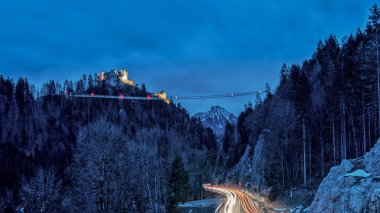highline179 Ideas & History
Today, it is hard to imagine that just over 20 years ago there were only a few wildly overgrown wall remnants in the area of Burgenwelt Ehrenberg. A driving force behind the successful restoration of the time-honored walls is the local architect Armin Walch, also managing director of Burgenwelt Ehrenberg.
It was precisely this gentleman who, back in 1998/1999, in the midst of the preservation work on the Schlosskopf fortress, had the idea of connecting the Ehrenberg castle ruins below with the Fort Claudia opposite across the valley by means of a bridge.
Due to an earlier trip to Nepal, he already had in mind a rope suspension bridge in the Tibetan style. It was a hard way from the vision to the realization, which could only be done by the tireless commitment of the acting persons. Armin Walch dealt in detail with the pedestrian suspension bridge in Holzgau and clarified the technical feasibility of such a bridge on Ehrenberg in talks with bridge builders.
In 2003, Walch presented his vision to the public for the first time and met with lively interest. Many planning sessions, inquiries and discussions with partners from the region later, 2012 was the year in which Armin Walch and Martin Kathrein from the Strabag company formed a project team to make the vision of "the world's longest pedestrian suspension bridge" a reality on Ehrenberg. Kathrein went looking for investors and found one: a private investor from the region liked the idea and took the risk of financing the construction of the pedestrian suspension bridge out of his own pocket.
The company Strabag implemented the construction in about 6 months and finally in November 2014 the highline179, world's longest pedestrian suspension bridge in Tibet style, could be opened. It held the title until 2017.








